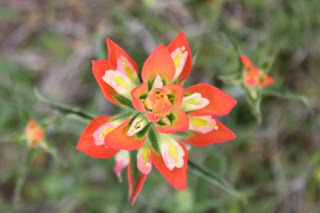The annual Texas wildflower fever is just beginning around here -- everybody loves wildflowers in March. It's kind of surprising that they do, to tell the truth. After all, most wildflowers have a rather weedy appearance close up. Our very favorite one, the Texas Bluebonnet, has a very short bloom cycle. As a group, they're fairly unreliable: sometimes we have a banner year, and sometimes, depending on the rain, we get nothing at all.
What interests me is how we got from wildflowers to garden flowers. I enjoy reading about the dedicated plant breeders who carry on improving our species plants until we can barely recognize them. Even more interesting? Reading about how genetic researchers use plant DNA to track human migrations, based on the plants (and pollens and seeds) they carried with them.
I like to think about those people who long ago were entranced by the subtle beauty of a native wildflower. What it must have been like to live in a world where all flowers were wildflowers! It seems incredible that we ended up here, in a world in which woodland plants bloom in the full sun, scentless roses flower 12 months long, and our wildflowers have morphed into bedding color. And a little sad, really, that we only appreciate seasonality, subtlety and brevity in March. After that? We move on to evergreen, everblooming, dwarfing sameness.
The Surprising Power of the Amateur Gardener
3 days ago






.jpg)




I too have been amazed at how all our beloved perennials have such pedestrian roots. What they did was breed out the undesirable characteristics like straggly form but, like you mentioned, the fragrance and more subtle color too. What bothers me most is when they breed out the food source for the insects.
ReplyDeleteIf you translate this - she writes so enchantingly - Stinsenpflanzen - comes from Steinhaus - once there was a castle or a monastery here, a planted garden - http://guenstiggaertnern.blogspot.com/2011/03/elfentanz.html
ReplyDeleteI have areas where only wildings grow. It's like a trip to another country to visit them.
ReplyDeleteI'm always interested to see the gardeners who must have only the latest cultivars. All my echinacea is the species. I haven't time to coddle specialty plants.